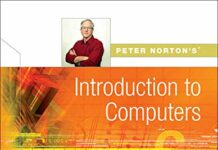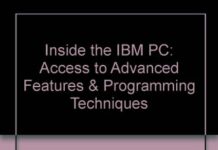
Ebook Info
- Published: 1987
- Number of pages: 413 pages
- Format: PDF
- File Size: 120.18 MB
- Authors: Peter Norton
Description
Programmers wanting to develop full-fledged programs in assembly language need this book. The more than 100,000 programmers who made the first edition an instant classic know: Norton and Socha team up to produce a primer for serious users.
User’s Reviews
Reviews from Amazon users which were colected at the time this book was published on the website:
⭐This wasn’t exactly what I wanted. I should have payed more attention this is for DOS IBM stuff . The shipper sent very quickly and the book arrived in good order. So I will give 5 stars for this.Other thoughts:This is neat to see where ASM starts for example moving the low level registers which for when this was written they were the registers…good seller and the price was dirt cheap. Thank you!
⭐Excellent book.
⭐Many thanks! No problems at all.
⭐As advertised
⭐Fantastic book, the best way to learn Assembly by far. Arrived quickly and in great condition, and is the only reason I passed my Computer Organization/Assembly class.
⭐Who knew Peter Norton was not only an exceptional coder but also an exceptional writer!His clear and casual style should be emulated by all technical books.By far the best book to learn assembly bar none!Before reading this book I thought the Jeff Duntemann assembly book was pretty good but this book makes it look bad!First half of book has you working in debug, which comes with every version of windows, and thus easier to get coding assembly than using Masm.2nd half covers Microsoft’s Masm but code still works with latest version of Microsoft Assembler 8.0 which I’m currently using!Except for the disk writing code of course, since modern versions of Windows won’t let you directly manipulate disk interrupts.
⭐Norton and Socha’s authority makes this book a must to every “beginner” assembly programmer. This book presents basic items such as binary numbers, registers & basic arithmetic inside the 8086 family processors into part 1. The contents of the book becomes closely related with DSKPATCH – a real program written in assembly – so the reader has a UNIQUE opportunity to see how real programmers (and here Norton is a PC guru) use step-wise refinements techniques and modular projects in a real world. The 2nd edition is based in MASM 5/5.1, Borland TASM and OPTASM features. Maybe we must wait for MASM 6.1 update… then it’ll become a rating 10…
⭐i’ve been struggling for ages to get a practical learn-and-do book on MASM 6 (DOS) x86 assembler, apart from the usual blah blah chapter on “this is binary”, the book takes you through a fascinating journey through using DEBUG.EXE to demonstrate what the registers do as you trace through a program, introduces you to the machine instructions (again using debug) and then takes you to Assembler, MASM and very quickly gets you coding and producing working code (COM files first, then EXE), it then takes you through wirting a disk sector editor in assembler from scratch, with DOS screen display, function keys, etc, all nicely using multiple files (libraries) and a MAKEFILE to compile. I’m about halfway through and loving the pace.For context, I’m a coder by trade c#/vb/java/jsPlatform i’ve settled on is, VSCODE to edit my files, and keep dosbos running in the background, mount my code directory into dosbox. edit in vscode, switch to dosbox to run “nmake”.. havent found a decent asm ide (tried visualasm but meh at the moment, and the vscode extensions seem to be in chinese only)
⭐A reference book. No more, no less.
Keywords
Free Download Peter Norton’s Assembly Language Book for the IBM PC in PDF format
Peter Norton’s Assembly Language Book for the IBM PC PDF Free Download
Download Peter Norton’s Assembly Language Book for the IBM PC 1987 PDF Free
Peter Norton’s Assembly Language Book for the IBM PC 1987 PDF Free Download
Download Peter Norton’s Assembly Language Book for the IBM PC PDF
Free Download Ebook Peter Norton’s Assembly Language Book for the IBM PC

